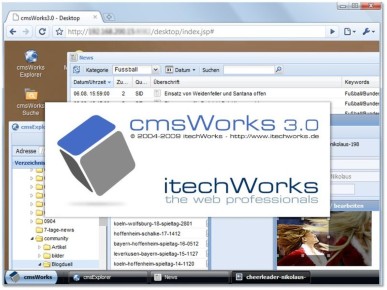cmsWorks' unique intuitive editors desktop, that feels more like a real application than a web-based Content Management System now comes with many new - small and huge - modules. In addition, important under-the-hood changes have been made to justify the new major version number of the (E)CMS.

Ideal support for editors
One of the extensions that will save time and nerves is the improved image tool. Editors can now resize, crop, turn, mirror and optimize uploaded pictures right at the CMS server with additional software.
cmsWorks offers further improvements in version 3 that support the editorial staff with their work in a best possible way and makes sure that one can concentrate on writing new contents.
- Fully personalization for the Editors Desktop. Now every editor can arrange the web-based desktop to his or her personal needs in an optimal way. Many configurations, starting from the language used in the desktop itself up to positions of icons and windows may be saved.
- Whenever you relog to cmsWorks, your working space will be restored just like it was when you logged out, so you can continue to work where you just interrupted.
- Every user can maintain a convenient list of favorites in respect of often used directories and documents. This is stored into the server based profile of the user as well.
- Copying-and-pasting texts and tables from Microsoft Word and Excel has been improved.
- The internal document search engine and the media asset management have got new features and filters to find documents even more efficient.
- Reverse search is now possible in a much easier way. With just one click one can see which documents link to an other given document.
- Data-grid/XML documents got an easy to use yet powerful input field. It is just as easy to use as a spread sheet application.
- The integrated media management system always uses the best-to-fit image dimension from a list of existing images.
cmsWorks 3.0: More possibilities for administrators
In particular maintenance and administration of Content Management System is often complex and time consuming. cmsWorks 2 already introduces many efficient ways to configure the document model, categories and navigation. Even changing advertisement can be done by the sales team without any technical support. cmsWorks 3 now comes with many new features which make it even easier to administer the system:
- The new permission model maintains user access based on grants and groups. Unlimited groups can be easily created, configured and assigned to editors. A LDAP/Kerberos (ADS) service was introduced.
- A site can now have several parallel navigation structures, providing additional ways for user guidance. In addition the work to configure the navigation had been cut down to the half and is more intuitive now.
- The new search is now fully programmable in a dynamical way. In multisite- and multilanguage-environments the search may be spread across all the sites.
Programming in cmsWorks 3.0
Introduced with version 2.2, the ContentScript Server provides a simpel yet powerful way to program even complex workflows and in cmsWork 3 the ContentScript Server is even more feature-rich. It allows to create small applications that work like "wizzards" across different desktop windows. The system even provides tools to create dialogs and interfaces without the need to acutally create code for it.
Other improvements for programmers include:
- The ContentScript Server now understands text fields with decorations without the need to create code for it.
- Integration and processing of XML via datagrid and datatable has been simplified very much.
- For programming and customization of the Editors Desktop many additional methods and configuration tasks have been introduces. And still only knowledge of JavaScript and CSS is needed.
- The copy-and-paste mechanism from external applications like Microsoft Word or Microsoft Excel has been improved and is now easily configurable to provide conversion capabilities. For example national quote signs, apostrophes and dashes may be replaced just as simple as proprietary signs like the Word-three-dots. This may be necessary in situations where content is not only show on the website but also exported to non UTF-8 systems or devices like mobile phones.
